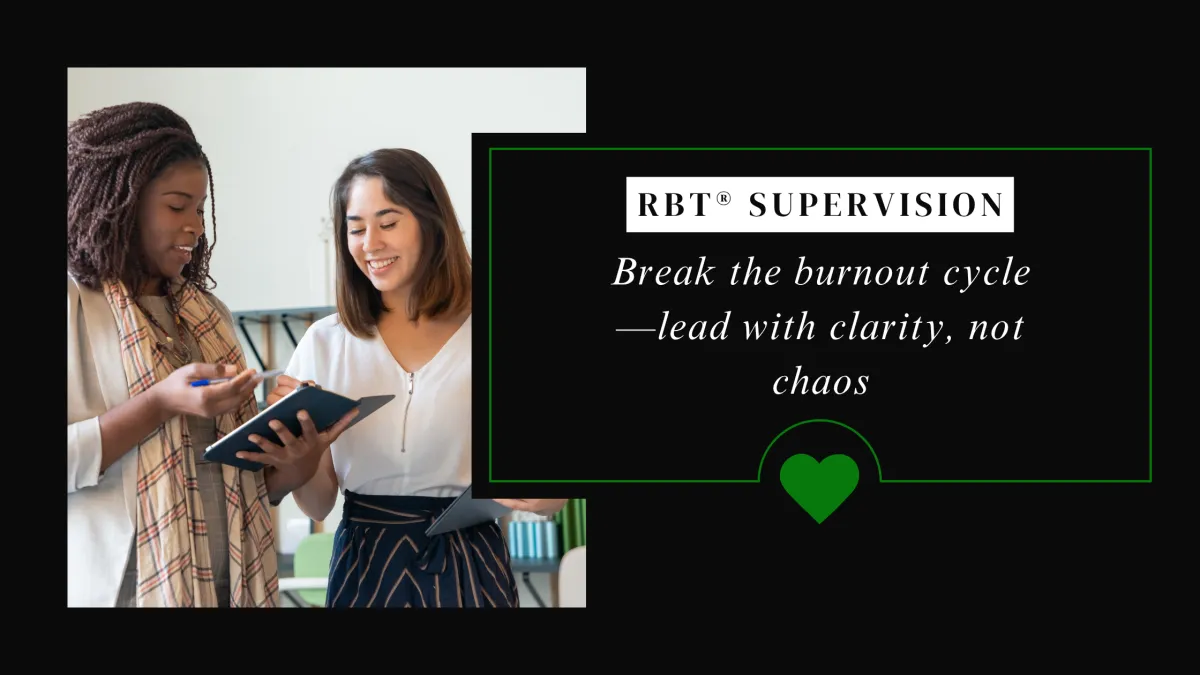
3 Mistakes That Are Burning You Out as a Supervisor (and How to Stop Making Them)
Let’s face it: BCBA® burnout isn’t just about long hours. It’s about invisible mental load, the kind that builds up when your supervision process feels like a never-ending game of Whac-A-Mole.
You've tried color-coded planners. You've re-read the 5th edition task list more times than you'd like to admit. And yet, somehow, you still feel like you're dropping the ball.
You're not broken. You're just stuck in a supervision loop that doesn't serve you.

3 Mistakes That Are Burning You Out as a Supervisor (and How to Stop Making Them)
The 3 Mistakes That Lead Straight to Burnout
1. Winging Supervision with No Roadmap
2. Treating Competency Like a Checklist
Ready to Take Your Supervision to the Next Level?
The 3 Mistakes That Lead Straight to Burnout
Research on clinical supervision (Sellers et al., 2019) and compassion fatigue in helping professions points to predictable patterns that drain us. Here are three of the biggest:
1. Winging Supervision with No Roadmap
Without a structured plan, every session becomes reactive. You’re improvising feedback, skipping important goals, and forgetting what you covered last week. It's not just inefficient—it erodes confidence in both you and your RBT®.
Quick Fix: Build a simple supervision rhythm. Think of it like a weekly circuit training plan: a consistent flow of observation, feedback, reflection, and goal review.
2. Treating Competency Like a Checklist
The RBT® task list is essential, but treating it as a one-and-done set of boxes to check off misses the point. Supervision should foster judgment, adaptability, and collaboration—not just technical accuracy.
Quick Fix: Use each skill as a doorway to deeper growth. Instead of just "prompt fading," ask: "How does the RBT® decide which prompt to fade, and when?"
3. Ignoring Soft Skills
Communication, cultural humility, self-regulation—these are the skills that make or break implementation. And yet, they often get sidelined because they feel "too abstract" to measure.
Quick Fix: Integrate soft skill check-ins into your regular process. Ask reflective questions. Give targeted praise. Use your data to coach human behavior, not just behavior plans.
Burnout as a Leaky Bucket
Picture your energy like a bucket. Every incomplete system, ambiguous expectation, or missed feedback opportunity is a hole. Structure isn't rigid—it's the sealant.
What the Research Shows
Burnout in BCBAs® is strongly associated with role ambiguity and lack of professional support (Plantiveau, Dounavi, & Virués-Ortega, 2018). Systems that clarify expectations and build feedback loops don't just prevent burnout—they build better clinical outcomes.
What You Can Do This Week
Try these low-lift interventions:
Set a theme for each month (e.g., reinforcement, rapport-building).
Co-create goals with your RBT® to foster ownership and reduce decision fatigue.
Use one reflective supervision question per session to promote shared insight.
The good news? You don't need more supervision hours. You need a structure that actually supports you.
Stay tuned for a tool designed with this exact balance in mind.
Ready to Take Your Supervision to the Next Level?
If you're feeling the pressure to make your RBT® supervision more meaningful and manageable, you're not alone. Supervising isn't just about compliance—it's about connection, clarity, and cultivating confident, competent behavior technicians. Whether you're just getting started or looking to refine your approach, you don’t have to reinvent the wheel.
For more actionable tips, tools, and real-world resources to elevate your RBT® supervision game, head over to www.elevateyourabasupervision.com. It’s your one-stop hub for building better systems, stronger relationships, and sustainable supervision practices.
Want to dive deeper? Check out these CEU courses designed specifically for BCBAs® who supervise:
The Retention Revolution: The Secret to Reducing RBT Burnout – Discover proven strategies to keep your RBTs® engaged, energized, and empowered.
The Supervisor's Toolbox: Strategies for Building Effective Relationships – Learn how to foster trust, transparency, and team cohesion with your supervisees.
The Feedback Loop: Engineering a Culture of Collaboration and Growth in ABA – Transform your feedback from one-sided to collaborative, ongoing, and growth-oriented.
Precision Supervision: High-Yield Tools for Thriving RBTs® and Balanced BCBAs® – Streamline your systems and amplify outcomes with efficient, research-backed practices.
What Your Training Didn't Cover: Closing the Cultural Humility Gap in Supervision – Address the often-overlooked dynamics that impact equity and effectiveness in supervision.
Whether you're managing burnout, building rapport, or boosting clinical impact—you're not in this alone. You're building something meaningful. Let's make sure your supervision reflects that.
References
Plantiveau, C., Dounavi, K., & Virués‑Ortega, J. (2018). High levels of burnout among early‑career board‑certified behavior analysts with low collegial support in the work environment. European Journal of Behavior Analysis, 19(2), 195–207.
Sellers, T. P., Valentino, A. L., Landon, T. J., & Aiello, S. (2019). Board certified behavior analysts’ supervisory practices of trainees: Survey results and recommendations. Behavior Analysis in Practice, 12(3), 536–546.
#BCBAlife #ABAmistakes #RBTtrainingtips #ABAworkflow #burnoutrecovery #compassionateABA #ABAsupervision
